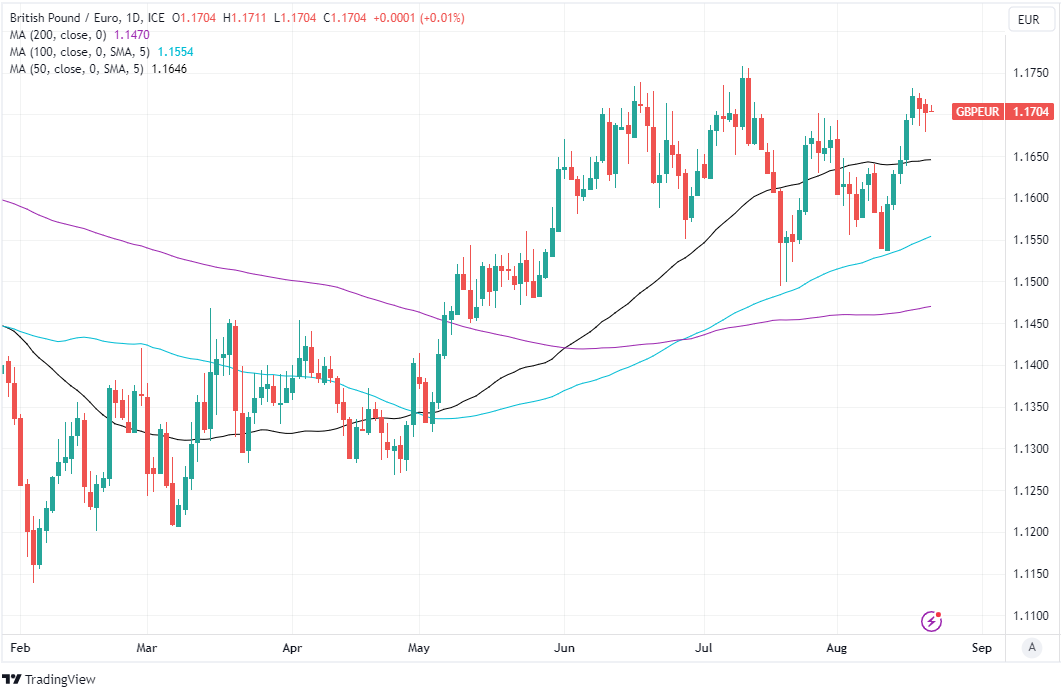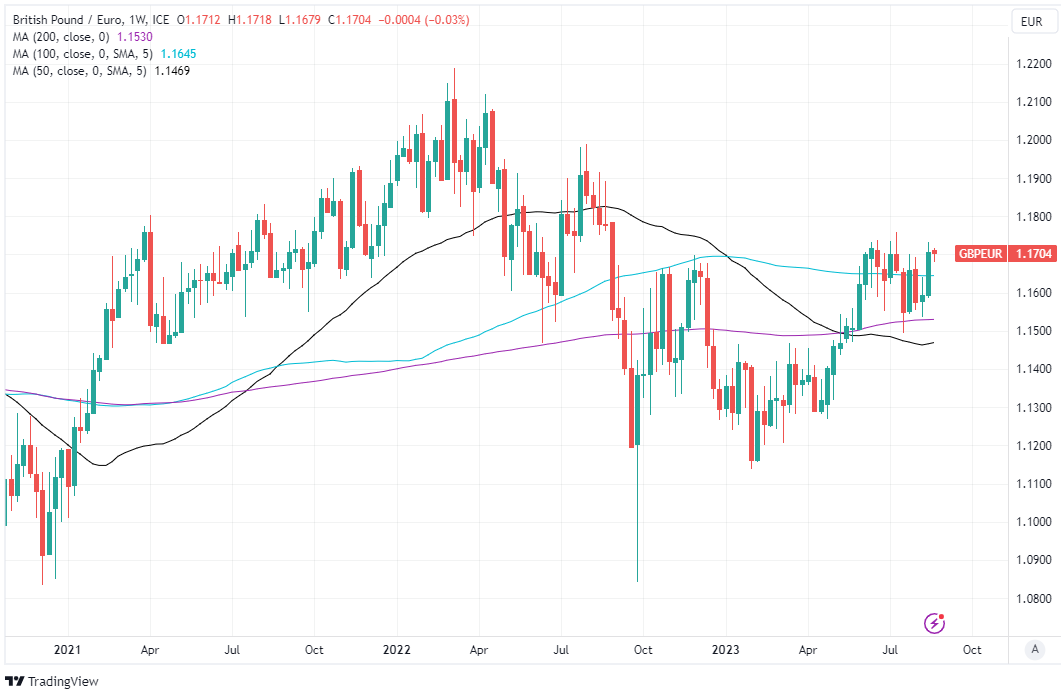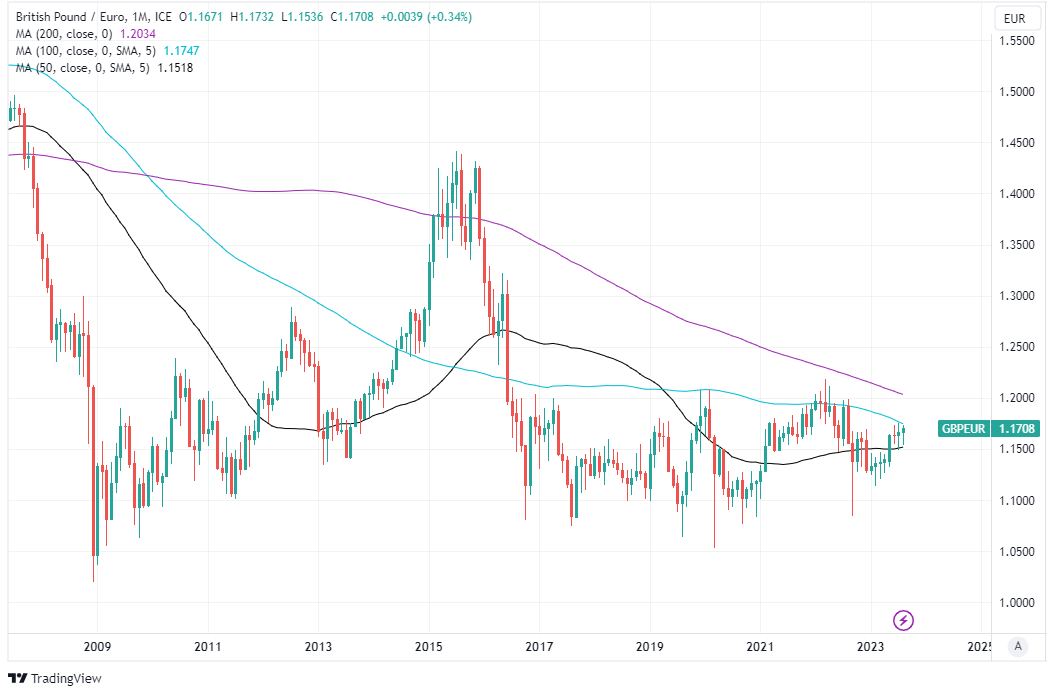GBP/EUR Week Ahead Forecast: Bilateral Growth Balance in Focus
- GBP/EUR supported near 1.1650 short-term
- But likely to struggle on approach of 1.1750
- PMIs & economic inflection potentially a risk

Image © Adobe Images
The Pound to Euro exchange rate entered the new week under pressure near the top of its three-month range and could be seen falling back toward its 55-day moving-average in the days ahead if business surveys offer any further sign of Europe’s economy catching up with or otherwise overtaking the UK economy.
Sterling struggled to hold 1.17 against the Euro on Monday and remained close to the level on Tuesday after being bogged down by falling UK house prices and reports of steep declines in sales at a national home builder due to the effects of higher interest rates and changes to government subsidies for first-time buyer deposits.
These were both potentially signs of things to come for the building sector and wider economy following the increase in the Bank of England (BoE) Bank Rate from 0.1% in December 2021 to 5.25% this August, which is set to be more fully felt by households in the months ahead as mortgages refinance onto higher rates.
“There are increasing sig that consumer resilience is waning – falling house prices, weak retail sales – which suggest that the combination of higher rates and stalling energy price disinflation are all starting to bite,” writes Dominic Bunning, European head of FX research at HSBC, in a Monday note
“Of course, downside risks to European data remain a concern, although we have rarely seen this degree of disappointment continue historically. As such, we think the timing is right for EUR-GBP to bounce from recent support around 0.85 [1.1764] and retest the middle of the last few months’ range [1.15],” he adds.
Above: Pound to Euro rate shown at daily intervals with selected moving averages indicating possible areas of technical support.
Despite its early stumble the Pound remained an outperformer of the recent week after inflation fell slightly less than expected and the average wage packet was reported to have grown at an accelerated pace last week, leading financial markets to bet on Bank Rate being raised from 5.25% to 6% by early next year.
But Bunning and colleagues say these kinds of expectations are a tall order that risks being disappointed by the BoE over the coming months, while they’ve also warned that a possible rebound in European economic figures could see the Pound to Euro rate under further pressure as soon as this week.
“The Bank of England's trade-weighted sterling index continues to trade near the highs of the year, no doubt propped up by high short-term interest rates,” writes Chris Turner, global head of markets and regional head of research for UK & CEE at ING.
“For this week, the UK calendar is light until Wednesday's release of PMI data. EUR/GBP can stay offered in a 0.8500-0.8550 range [GBP/EUR: 1.1695 to 1.1764],” he adds.
Wednesday’s S&P Global PMI surveys of the manufacturing and services sectors are the highlights of an otherwise quiet week for the UK economic calendar though the European surveys are followed on Friday by the release of the German Ifo Business Climate survey and final estimate of second quarter GDP.
Above: Pound to Euro rate shown at weekly intervals with selected moving averages indicating possible areas of technical support.
Sentiment toward the European economy has been downbeat this year and continental economic data has often underwhelmed the UK’s though the most recent economic growth figures and remarks made by German Chancellor Olaf Scholz last week might suggest a turning point at hand.
“Germany has come through this time of crisis much better than many people predicted,” Chancellor Scholz said while speaking of a business investment boom underway at an event to mark North Rhine Westphalia Entrepreneur Day last week.
“It is sometimes a bit strange that on the same day, in the same program or in the same newspaper, these billion-dollar direct investments are reported and then the general complaint arises that the opposite is the case. I think the facts should count,” he added.
German business investment is currently growing by around one percent per year from taxpayer funding alone while economic growth figures released last week suggested the overall Eurozone economy grew at an accelerated pace of 0.3% in the second quarter to exceed the pace of expansion in the UK.
This potentially places Germany and Europe on course to overtake the UK in the growth table as soon as the current quarter and as far as that is the message in Wednesday’s S&P Global PMI surveys it could serve as a catalyst for Sterling to begin topping out against the Euro or perhaps even correcting lower.
Above: Pound to Euro rate shown at monthly intervals with selected moving averages indicating possible areas of technical support.
“Recently, weak European activity data has seen the EUR soften as the market has lowered its expectations for further rate hikes. Current pricing suggests only a 50% chance of a further 25bp hike on 14 September,” HSBC’s Bunning says on Monday.
“We think sticky core inflation dynamics will see the ECB hike again and this should provide some support for the currency as we approach the meeting,” he adds.
The alternative possibility for the Pound is one where the S&P surveys continue to indicate a more resilient UK economy despite interest rates having risen around a percentage point less while taking longer to impact households in some parts of Europe.
Such an outcome, if combined with more downbeat data from Germany on Friday, could lead GBP/EUR to rise back above 1.17 and potentially begin targeting a move up toward 1.19, though it’s possible or perhaps even likely that this turn of events would draw yet more sellers out of the woodwork.
“We continue to see risks between GBP and the EUR as well balanced and expect more range trading around the EUR/GBP 0.86 [GBPEUR: 1.1630] area on a 1-to-3-month view,” says Jane Foley, head of FX strategy at Rabobank, in a Monday forecast review.



